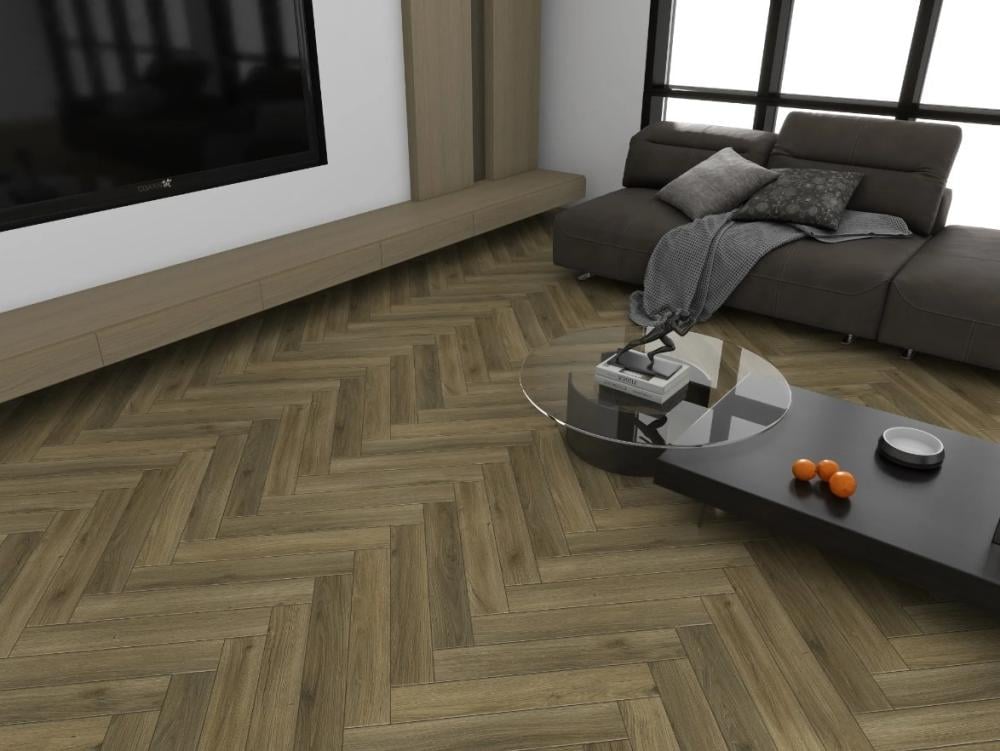Parquet is a type of wood flooring that is made by arranging small strips of wood in distinct repeating patterns.
While traditional parquet was installed one piece at a time, most modern parquet comes in the form of tiles where wood strips are glued to a backing material.
Parquet flooring is installed by gluing, nailing or stapling to the subfloor. Because parquet laminates are made from hardwood, parquet flooring is similar in appearance and performance to traditional hardwood flooring made from solid wood pieces.
Parquet flooring components
Parquet flooring is made from thin strips of wood joined together to create a direct, attractive pattern on the floor or is installed as pre-finished parquet tiles. Tiles usually come in common sizes such as:
- 9" x 9".
- 12" x 12".
- 19" x 19".
Tile thickness typically ranges from 5/16 inch to 3/4 inch. Parquet tiles usually have a backing layer made of paper, fabric or plastic stitched to a thin metal or plastic backing.
The top layer of wood is often oak but can also be of other common wood species such as maple and walnut.
Advantages and disadvantages of parquet flooring
Advantages
1- Elegance and aesthetics:
Parquet flooring is elegant and bold, making it a popular choice in basic rooms like living rooms, dining rooms, and hallways, as well as mid-century modern home styles.
- Naturalness and warmth: Parquet is made of natural wood, which adds unique beauty and warmth to the space.
- You can enjoy the wood's natural tones and distinctive details that add a warm, cohesive feel to the floor.
- Elegance and design: Parquet is distinguished by its diverse and elegant designs. You can choose from a wide range of styles, colors and finishes to suit your personal taste and the decor of the space. Whether you prefer light-colored parquet with a pure look or dark-colored parquet with an elegant appearance, you will find an option that suits you.
- Gloss and shine: The surface finish of the parquet gives a wonderful shine and natural shine. You can choose a matte finish or a glossy finish depending on your personal preference. No matter which finish you choose, you'll have a floor that looks beautiful and bright.
- Strength and durability: The parquet is made of high-quality hardwood, which makes it durable and strong. Parquet can withstand traffic and daily use without being significantly affected. Scratches and minor damage can also be easily repaired by refinishing the surface.
- Ease of cleaning: Parquet is an easy-to-clean floor. You can use a vacuum cleaner or dry mop to remove daily dust and impurities. Additionally, you can use a certified wood cleaner to clean tough stains and keep your parquet looking beautiful.
2- Ease of maintenance:
Parquet floors can be cleaned just as easily as any other wooden floor by simply vacuuming and dry mopping them at least once a week. It is also possible to easily avoid scratches by placing rugs and rugs under the chairs.
3- Durable:
Solid parquet is structurally strong and can remain beautiful for decades.
4- Ease of installation:
Parquet strips are thin and easy to cut, can be easily arranged and adhere well to flat floors instead of being fastened with nails.
Wood species options:
You can choose from a variety of wood options to create a parquet flooring design.
Defects
1- Exaggerated decoration:
The geometric patterns of parquet can sometimes be visually overwhelming for some, and this is especially true in kitchens, bathrooms, and small spaces due to lack of space, and can give the room a sense of crowding.
2- Damage in humid environments:
Parquet can be damaged and cause other problems if used in damp or underground environments in a basement.
3- Prone to scratches:
Wood is easily exposed to scratches and scratches, and it is difficult to remove these marks from the parquet floor in some cases.
Parquet flooring patterns
Regardless of your parquet design, each piece in the pattern is unique and individual. In the art of parquet, pieces and strips are also known as “fingers”. Here are the most popular styles of parquet:
- Herringbone: A wavy pattern using rectangular blocks or bands with straight ends.
- Chevron: A wavy pattern using bands holding ends that form a 45-degree angle to create a true V shape.
- Basketweave: Strips of wood appear to be tangled under and over each other.
- Checkerboard: Strips of wood create cubes that form a checkerboard pattern.
- Mosaic or Brick (also known as “square on square”): Thin wood strips of equal size that form a square and are placed next to each other to create a pattern.
- Versailles: A specific texture of strips of wood in a particular shape.
Ready parquet versus unfinished parquet
In its natural, unfinished state, parquet can be stained and damaged and must be finished to protect its wood surface. Unfinished tiles are polished, stained and finished on site after the floor is installed. This allows you to choose the tint color or type of finish you desire, giving you many decorative options.
While the finished parquet tiles are pre-treated with a durable, synthetically applied wood varnish. Because it is done artificially, the finish can be much more durable than applied on site. This can also reduce the hassle and mess of applying the finish in your home.
Parquet, water and moisture
In general, parquet tiles withstand humid environments better than individual installations of solid parquet. Individual slats in tile form are less likely to swell and shrink during changes in humidity. However, because parquet is made of wood, both tiles and laminates are still susceptible to damage, and can be prone to swelling or developing green spots in highly humid environments such as heavily used bathrooms.
Renewal of parquet floors
Parquet is basically made of wood and can therefore be polished and renewed. Parquet tiles can be renewed approximately the same number of times as hardwood flooring of similar thickness.
However, parquet flooring is not as easy to renovate as regular hardwood flooring due to the alternating grain directions in the wood materials. Alternatively, small slices of wood may be oriented in different directions. This can result in occasional scratches on the grain, which can be difficult to remove. You may even need to resort to manual polishing in some places to get a smooth surface.
Always turn to experts in this regard so that the renovation or repair process is completed in the best way and without leaving any unwanted effects.
common questions
Is parquet expensive?
The cost of parquet ranges in price depending on whether it is a custom installation or ready-made parquet tiles. You can view all prices by browsing the parquet section on our website. Parquet and wood flooring
Is parquet made of real wood?
Parquet flooring is made from thin pieces of real wood, which are joined together to create elegant patterns and shapes.
In conclusion, parquet can be a great choice for your home's flooring, especially if you are looking to add an artistic and elegant touch. Although it has some drawbacks, its aesthetics and durability make it a popular and successful choice in many homes, offices, rooms and hallways.

